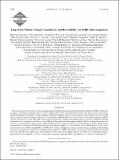Long-Term Climate Change Commitment and Reversibility: An EMIC Intercomparison
Author(s)
Forest, Chris E.; Monier, Erwan; Schlosser, Adam; Sokolov, Andrei P.
DownloadZickfeld-2013-Long-Term Climate Ch.pdf (5.715Mb)
PUBLISHER_POLICY
Publisher Policy
Article is made available in accordance with the publisher's policy and may be subject to US copyright law. Please refer to the publisher's site for terms of use.
Terms of use
Metadata
Show full item recordAbstract
This paper summarizes the results of an intercomparison project with Earth System Models of Intermediate Complexity (EMICs) undertaken in support of the Intergovernmental Panel on Climate Change (IPCC) Fifth Assessment Report (AR5). The focus is on long-term climate projections designed to 1) quantify the climate change commitment of different radiative forcing trajectories and 2) explore the extent to which climate change is reversible on human time scales. All commitment simulations follow the four representative concentration pathways (RCPs) and their extensions to year 2300. Most EMICs simulate substantial surface air temperature and thermosteric sea level rise commitment following stabilization of the atmospheric composition at year-2300 levels. The meridional overturning circulation (MOC) is weakened temporarily and recovers to near-preindustrial values in most models for RCPs 2.6–6.0. The MOC weakening is more persistent for RCP8.5. Elimination of anthropogenic CO[subscript 2] emissions after 2300 results in slowly decreasing atmospheric CO[subscript 2] concentrations. At year 3000 atmospheric CO[subscript 2] is still at more than half its year-2300 level in all EMICs for RCPs 4.5–8.5. Surface air temperature remains constant or decreases slightly and thermosteric sea level rise continues for centuries after elimination of CO[subscript 2] emissions in all EMICs. Restoration of atmospheric CO[subscript 2] from RCP to preindustrial levels over 100–1000 years requires large artificial removal of CO[subscript 2] from the atmosphere and does not result in the simultaneous return to preindustrial climate conditions, as surface air temperature and sea level response exhibit a substantial time lag relative to atmospheric CO[subscript 2].
Date issued
2013-08Department
Massachusetts Institute of Technology. Center for Global Change ScienceJournal
Journal of Climate
Publisher
American Meteorological Society
Citation
Zickfeld, Kirsten, Michael Eby, Andrew J. Weaver, Kaitlin Alexander, Elisabeth Crespin, Neil R. Edwards, Alexey V. Eliseev, et al. “Long-Term Climate Change Commitment and Reversibility: An EMIC Intercomparison.” J. Climate 26, no. 16 (August 2013): 5782–5809. © 2013 American Meteorological Society
Version: Final published version
ISSN
0894-8755
1520-0442